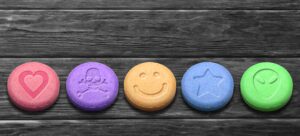Embarking on an ecstasy-fueled journey is a whirlwind of euphoria, vibrant sensations, and boundless connection. However, as the pulsating beats of the night fade, a stark contrast emerges. The initial cascade of bliss gives way to a shadowed aftermath — the dreaded ecstasy comedown. Fatigue and cravings replace the once-boundless energy and the vibrant hues of ecstasy yield to feelings of stress and anxiety.
In this article, we explore what to expect from an ecstasy comedown and give you five valuable tips for combatting the worst of the symptoms.
Need help qutting ecstasy? Call La Fuente at 888.903.9898.
What is Ecstasy?
Also known as molly, E, MD, or MDMA, ecstasy is a popular club drug found at bars, nightclubs, raves, and festivals. The drug’s official name is 3,4-methylenedioxy-methamphetamine. This synthetic compound shares similarities with both stimulants and hallucinogens.
Ecstasy is available in several forms including capsules, tablets, liquid, or powder. Typically ingested orally, users generally start to experience a euphoric high within 20 to 40 minutes of consumption, with peak effects hitting within the initial 90 minutes. From there, the high usually lasts anywhere from three to six hours.
It’s popular in the club scene for the initial pleasurable effects it gives.
These include:
- Feelings of euphoria and bliss
- Increased energy
- Heightened perception of colors and sound
- Increased sociability
- Enhanced feelings of love, trust, empathy, and sexual desire
Ecstasy’s Impact on the Brain
MDMA’s initial effects are linked to increased neurotransmitter activity in the brain. More specifically, it affects serotonin, dopamine, and norepinephrine.
Often referred to as the “feel-good chemical,” serotonin is responsible for regulating moods, sexual behavior, aggression, pain sensitivity, and sleep. Ecstasy causes an excess release of serotonin, resulting in heightened euphoric feelings.
Ecstasy also triggers the release of dopamine, another neurotransmitter responsible for pleasurable sensations and the reinforcement of behaviors leading to them. Essentially, ecstasy boosts energy and happiness levels while activating the brain’s reward system, fostering a cycle of continued drug use.
Elevated levels of norepinephrine further contribute to the experience of euphoria, emotional excitement, and cognitive impairment associated with ecstasy use.
What to Expect from an Ecstasy Comedown
As the effects of the drug wear off, individuals may begin to experience unpleasant aftereffects. Some of the most common symptoms during this phase include:
- Feelings of depression
- Anxiety
- Irritability or aggression
- Shakes or tremors
- Jaw clenching
- Loss of appetite
- Insomnia, along with nightmares, night terrors, and sleepwalking
- Extreme fatigue
- Impaired memory
- Decreased sex drive
The combination of physical and psychological discomfort resulting from an ecstasy comedown often motivates individuals to seek more of the drug to alleviate these negative symptoms. Left unchecked, this euphoria/comedown cycle can easily lead to addiction.
How Long Does an Ecstasy Comedown Last?
The duration of an ecstasy comedown is influenced by factors such as the quantity of the drug ingested, the duration of consumption, concurrent use of other substances (such as alcohol), and the individual’s mental and physical health.
Typically, this process lasts approximately 24 hours, although in certain cases, it may persist for several days.
It’s important to highlight that if a person continues taking ecstasy to alleviate comedown symptoms, the subsequent comedown can be prolonged, resulting in several withdrawal symptoms that can last for days.
5 Tips for Managing an Ecstasy Comedown
While an ecstasy comedown will never be pleasurable, there are ways to alleviate the symptoms.
1. Take care of yourself physically
This tip may seem obvious, but it’s easier said than done, especially when you’re feeling physically and mentally drained. Here are some best practices:
- Eat nutritious food – Ecstasy robs you of your appetite, but do your best to consume antioxidant-rich foods. Your body needs the energy.
- Hydrate – Drink water, coconut water, or electrolyte drinks like Gatorade. At the same time, avoid coffee and tea as these will only dehydrate you further.
- Take magnesium tablets – Magnesium helps relax your muscles, something that can help alleviate any pain you experience as a result of jaw clenching.
- Rest – You’re likely feeling exhausted, so make sure to nap or engage in calming activities.
Do some light exercise – Engage in a low-impact activity like yoga or walking to boost your natural supply of serotonin.
2. Attend to your mental health
While addressing the physical symptoms of an ecstasy comedown is crucial, it’s equally vital to prioritize your mental well-being. That’s because many users contend with feelings of depression, anxiety, and stress following drug use.
Combat these symptoms by meditating, practicing mindfulness, or engaging in breathing exercises. Creative activities such as coloring, gardening, baking, or singing may also help regulate stress hormones.
3. Don’t take more drugs
As uncomfortable as the symptoms are, try to remember that they’re temporary. Taking another dose to ease ecstasy comedown symptoms might provide short-term relief, but you’ll end up suffering more in the long term. In fact, chasing away symptoms could inadvertently set you on a euphoria/comedown cycle that’s tough to escape.
4. Speak to someone
Whether it’s a friend, family member, or therapist, confide in someone you trust about your comedown experience and your drug cravings. Sharing your concerns won’t eliminate the symptoms, but gaining an objective, logical perspective may help lessen the intensity of the cravings.
5. Distract yourself
If all else fails, try distracting yourself from your comedown symptoms by visiting friends, watching a movie, going for a drive, or listening to music.
Ecstasy Treatment at La Fuente Hollywood
Members of the LGBTQ community are more affected by drug use when compared to the general population. This discrepancy is especially pronounced in the case of ecstasy, largely due to its prevalence as a club drug. Given that a significant portion of LGBTQ social activities take place in venues like bars, clubs, raves, and festivals, it makes sense that our community comes in contact with this dangerous drug more often.
As a leading LGBTQ-focused drug treatment center, La Fuente Hollywood is uniquely positioned to assist members of our community in overcoming ecstasy use. Our Southern California rehab center provides a range of services that address ecstasy comedown and abuse, including medically supervised detox, residential addiction treatment, and outpatient options such as partial hospitalization and intensive outpatient programs.
For more information about our programs, please contact us today at 888.903.9898.




